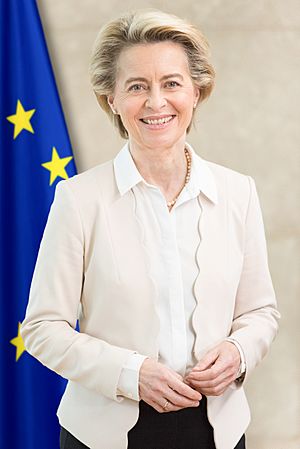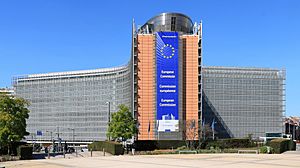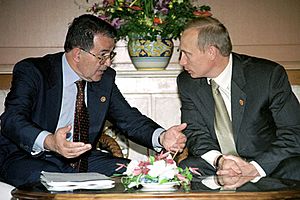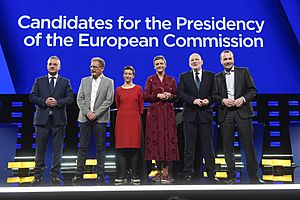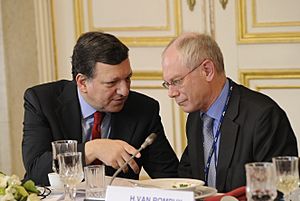President of the European Commission facts for kids
Quick facts for kids President of the European Commission |
|
|---|---|

|
|

Logo of the Commission
|
|
| European Commission | |
| Style | President |
| Member of | College of Commissioners European Council |
| Reports to | European Parliament European Council |
| Seat | Berlaymont, Brussels, Belgium |
| Nominator | European Council |
| Appointer | European Parliament |
| Term length | Five years, renewable |
| Constituting instrument | Treaties of the European Union |
| Formation | 1 January 1958 |
| First holder | Walter Hallstein |
| Deputy | First Vice-President of the European Commission |
| Salary | €306,655 |
The President of the European Commission is like the main leader or "head" of the European Commission. This Commission is the executive part of the European Union (EU), similar to a government's cabinet. The President leads a team of other leaders called Commissioners. This team is known as the College of Commissioners.
The President decides what jobs each Commissioner does. They can also change these jobs or even ask a Commissioner to leave. The College of Commissioners guides the Commission's staff. They also decide what new ideas and laws the EU should work on. The European Commission is the only group that can suggest new laws for the EU.
The Commission President also represents the EU to other countries. They work with the President of the European Council and the High Representative of the Union for Foreign Affairs and Security Policy. This important job started in 1958. Each new President is chosen by the European Council and then voted for by the European Parliament. They serve for five years and can be chosen again. The President also gives a yearly speech to the European Parliament about the "State of the Union."
In July 2019, the European Council suggested Ursula von der Leyen for the job. She was then elected by the European Parliament on July 16, 2019. She became the 13th President on December 1, 2019. This happened after her team of Commissioners was approved. She was re-elected on July 18, 2024.
Contents
History of the Commission President
How the Job Started
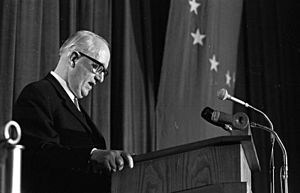
The European Commission was created by the Treaty of Rome in 1957. It took over from older groups in 1967. The first President was Walter Hallstein. He worked to make European law stronger. He also made sure it had an impact on laws in different countries. At first, national governments didn't pay much attention to his work. So, President Hallstein had to show the Commission's power early on. With help from the European Court of Justice, the Commission started to be taken more seriously.
In 1965, Hallstein suggested new ideas for farming in Europe. These ideas would give the EU its own money. They would also give more power to the Commission and Parliament. France's President, Charles de Gaulle, didn't like these ideas. He thought Hallstein was acting like a country's leader. France even pulled its representative out of the Council. This caused a big problem called the "empty chair crisis." Even though the problem was solved, Hallstein was blamed. The Council did not let him continue his term.
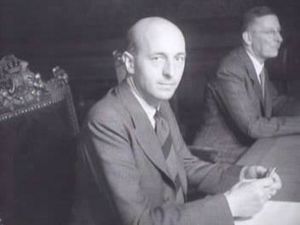
From 1967 to 1985
Hallstein's work made the Commission a powerful group. In the 1970s, Presidents helped with big projects. One was creating a single European money system. In 1970, President Jean Rey made sure the EU had its own money. In 1977, President Roy Jenkins was the first Commission President to attend a G7 meeting. This showed the EU's growing importance.
However, problems like the oil crisis in the 1970s made European unity less important. Countries focused more on their own economic issues. The EU went through a tough time called "eurosclerosis." This was due to money problems and disagreements over the EU budget. During this period, the President's influence was not very strong.
A Stronger Presidency

The Commission started to get stronger again under President Jacques Delors. Many people see him as the most successful President. He gave the EU a clear direction and new energy. When he started, people were not very hopeful about Europe. But he brought new life to the EU and the Commission. He pushed for a single market in Europe. Later, he worked towards a stronger economic and political union.
Delors not only improved the EU, but he also changed the role of the President. Before him, the President was just one of many important leaders. After him, the President became the clear leader of the EU. Later treaties made this change official. The President gained control over assigning jobs to Commissioners. They could also make Commissioners resign. When President Romano Prodi took office with these new powers, some people called him "Europe's first Prime Minister."
Parliament's Role
In the past, the Council chose the Commission President without much input from the European Parliament. But with the Treaty on European Union in 1993, the Parliament gained more power. The Parliament is directly elected by EU citizens. It got the right to be asked about the President's choice. It could also reject the whole Commission. The Parliament used this right to veto the President, and the Council eventually agreed. This power was made official in the Amsterdam Treaty.
In 2004, several candidates were put forward. The center-right parties won the most votes. José Manuel Barroso was chosen as President. But the Parliament made him change some of his chosen Commissioners. This showed how much power the Parliament now had. In 2009, Barroso was re-elected. The Parliament again pushed for changes to his team. It also gained more say in how the Parliament is represented in EU meetings. On September 7, 2010, Barroso gave the first yearly "State of the Union" speech to Parliament.
How the President is Chosen
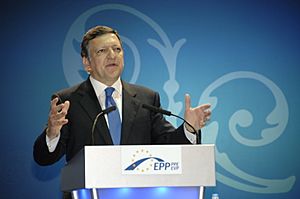
The Treaty of Lisbon explains how the President and their team are chosen. First, the European Council suggests a candidate for President. They consider the results of the latest European elections. This means they often look at which political party won the most votes.
Then, this suggested candidate goes before the European Parliament. The Parliament must approve or reject the choice. If more than half of the Members of the European Parliament (MEPs) vote for the candidate, they are elected. After that, the President and the Council suggest the rest of the team of Commissioners. Each Commissioner candidate has to appear before a special Parliament committee. This committee checks if they are suitable for the job. Finally, the Parliament votes on the entire team of Commissioners. If approved, the European Council officially appoints the President and their team.
Choosing the Best Candidate
The person chosen by the Council is often a well-known national politician. However, this is not a strict rule. The choice of President should consider the results of the European elections. For example, they might choose someone from the political party that won the most votes. This idea is called the Spitzenkandidat principle.
Other things that influence the choice include:
- Which part of Europe the candidate comes from.
- How much political influence they have.
- Their language skills, especially French.
- How involved their country is in the EU, like being part of the eurozone or Schengen Agreement.
It used to be thought that a President from a large country would be followed by one from a small country. Also, a left-wing President might be followed by a right-wing one. However, these choices often come from political battles and deals between countries.
The Spitzenkandidat Idea
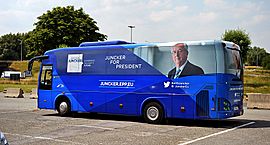
The Spitzenkandidat (which means "lead candidate" in German) process connects the choice of Commission President to the European Parliament elections. Each major European Political Party names their candidate for President before the elections. The candidate from the party that wins the most votes (or can form a majority) would then be expected to become the Commission President. This process was first used in 2014.
How Long They Serve
The President is elected for a five-year term. They can be re-elected. Their term starts five months after the European Parliament elections. These elections happen every five years, in years ending in 4 and 9. This timing helps connect the elections more closely to the President's role.
The President and their team can be removed from office by a special vote from the Parliament. This is called a "vote of censure." The Parliament has never done this. However, in 1999, the Santer Commission resigned on its own. This happened because they were about to face a vote of censure due to money problems.
What the President Does
The President of the European Commission has a very powerful job in the European Union. They control the Commission, which is the only group that can suggest new EU laws. The President decides the main goals and plans for the Commission during their term. In fact, no new policy can be suggested without the President's approval.
The President's main role is to lead the Commission. They guide the whole EU. The treaties say that "the Commission shall work under the political guidance of its president." The President does this by leading meetings of the Commissioners. They can also ask a Commissioner to resign if needed. The Commission works as a team, but the President is clearly the main leader. Their role is much like a national prime minister leading a government.
The President also represents the Commission both inside and outside the EU. For example, they are a member of the European Council. They also take part in discussions in the Parliament and the Council of Ministers. Outside the EU, they attend meetings like the G8 to represent the Union.
The President's office is on the 13th floor of the Berlaymont building in Brussels. The President gets advice from their personal team, called their cabinet. The head of this cabinet acts like a political helper for the President. The President also has power through the legal service and the Secretariat-General of the Commission. These groups help the President guide the Commission's work.
After the Lisbon Treaty changed some top EU jobs, there was some confusion about who did what. An ambassador from Ukraine explained it simply: The Commission President acts like the EU's "government." The President of the European Council is the "strategist" who plans for the future. The High Representative handles "relations with other countries." The President of the European Parliament speaks for the EU's values.
Working with the European Council President
Even though the Commission President is powerful, they still need support from the Council and Parliament. It can be hard for the President to get all countries to agree, especially with so many member states now. The Parliament also has more power over the Commission.
There used to be some confusion between the roles of the Commission President and the permanent President of the European Council. Some people worried about them competing. But it was clarified that the European Council President is the "strategist," and the Commission President is like a "head of government." At international meetings, both Presidents represent the EU. The Commission President usually talks about money matters, and the European Council President talks about political issues.
There is a possibility that one person could hold both jobs in the future. The European Council President cannot hold a national job, but they can hold another EU job. So, the Commission President, who is already part of the European Council, could also become its President. This would combine the powers of both top executive roles into one "President of the European Union."
Benefits of the Job
The President's basic monthly salary is set at a high level. In 2013, it was about €25,351 per month. This also includes money for a home and other expenses, like schooling for children.
List of Presidents
The European Economic Community was created in 1958. The European Union is its legal successor. So, the list of Presidents starts with the first President of the European Economic Community. The Treaty of Lisbon in 2009 officially renamed the Commission to the European Commission.
Groups
- Christian Democrats / European People's Party
- Liberals / Liberal Democrats
- Socialists
- Progressive Democrats
| N. | Portrait | President (Born–Died) |
State | Took office | Left office | Commission | Party | Group | Electoral mandate | Refs | |
|---|---|---|---|---|---|---|---|---|---|---|---|
| 1 | 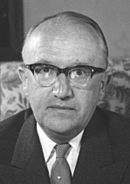 |
Walter Hallstein (1901–1982) |
1 January 1958 | 5 July 1967 | Hallstein | CDU | Christian Democrats | – | |||
| 9 years, 185 days | |||||||||||
| 2 | 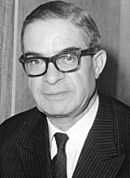 |
Jean Rey (1902–1983) |
6 July 1967 | 1 July 1970 | Rey | PLP | Liberals | – | |||
| 2 years, 361 days | |||||||||||
| 3 | 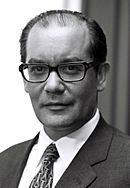 |
Franco Maria Malfatti (1927–1991) |
2 July 1970 | 21 March 1972 | Malfatti | DC | Christian Democrats | – | |||
| 1 year, 264 days | |||||||||||
| 4 | 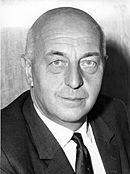 |
Sicco Mansholt (1908–1995) |
22 March 1972 | 5 January 1973 | Mansholt | PvdA | Socialists | – | |||
| 290 days | |||||||||||
| 5 | 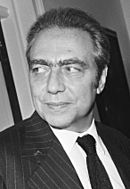 |
François-Xavier Ortoli (1925–2007) |
6 January 1973 | 5 January 1977 | Ortoli | UDR | Progressive Democrats | – | |||
| 4 years | |||||||||||
| 6 | 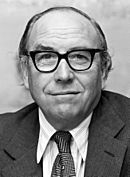 |
Roy Jenkins (1920–2003) |
6 January 1977 | 5 January 1981 | Jenkins | Labour | Socialists | – | |||
| 4 years | 1979 | ||||||||||
| 7 | 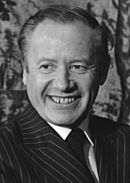 |
Gaston Thorn (1928–2007) |
6 January 1981 | 5 January 1985 | Thorn | DP | Liberal Democrats | ||||
| 4 years | |||||||||||
| 8 |  |
Jacques Delors (1925–2023) |
6 January 1985 | 22 January 1995 | Delors | PS | Socialists | 1984 1989 |
|||
| 10 years, 17 days | |||||||||||
| 9 | 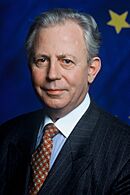 |
Jacques Santer (born 1937) |
23 January 1995 | 15 March 1999 | Santer | CSV | European People's Party | 1994 | |||
| 4 years, 51 days | |||||||||||
| – |  |
Manuel Marín (1949–2017) acting |
15 March 1999 | 15 September 1999 | PSOE | Socialists | |||||
| 185 days | |||||||||||
| 10 | 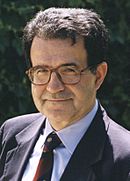 |
Romano Prodi (born 1939) |
16 September 1999 | 21 November 2004 | Prodi | Democrats | Liberal Democrats | 1999 | |||
| 5 years, 66 days | |||||||||||
| 11 | 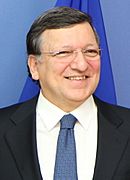 |
José Manuel Barroso (born 1956) |
22 November 2004 | 31 October 2014 | Barroso | PSD | European People's Party | 2004 2009 |
|||
| 9 years, 344 days | |||||||||||
| 12 |  |
Jean-Claude Juncker (born 1954) |
1 November 2014 | 30 November 2019 | Juncker | CSV | European People's Party | 2014 | |||
| 5 years, 29 days | |||||||||||
| 13 | 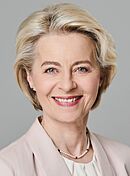 |
Ursula von der Leyen (born 1958) |
1 December 2019 | Incumbent | Von der Leyen I · II | CDU | European People's Party | 2019 2024 |
|||
| 6 years, 17 days | |||||||||||
Timeline of Presidents

See also
 In Spanish: Presidente de la Comisión Europea para niños
In Spanish: Presidente de la Comisión Europea para niños
- Vice-President of the European Commission
- European Commissioner
- List of presidents of EU institutions
- President of the European Parliament
- President of the European Council
- Presidency of the Council of the European Union
- President of the European Union
External links
- Commission President (official website)
- Terms of office
- Organisation of the European Commission CVCE (Previously : European NAvigator)
- Presidential candidates debate 2014
vi:Danh sách chủ tịch Ủy ban châu Âu


